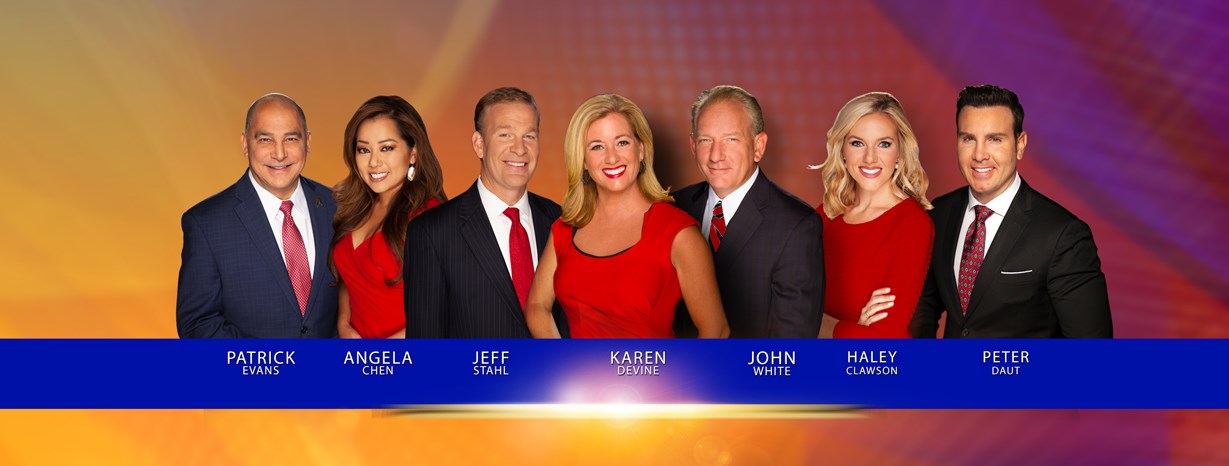For those who tuned in to KESQ News Channel 3 (KESQ) for Emmy color commentary before and after the September 19 national awards show, here’s a surprise: the network itself was also an Emmy winner this year.
On June 5, the National Academy of Television Arts & Sciences (NATAS) announced that KESQ won not one, but two Emmys – one for a morning broadcast and the other for an evening segment. “It’s very unusual for a station to win for morning and evening news broadcasts at the same time,” said Jerry Upham, KESQ’s general manager. “We’re very proud of that.”
“We were one of the smallest markets in our grouping that won,” said Rebecca Johnson, News Director for KESQ and the other News-Press & Gazette Company assets in our region – including CBS2 Local 2 and KDFX-FOX11 Palm Springs – noting that, “we’re judged among our peers and it’s always nice to get that recognition.” In order to compare apples to apples, NATAS has its markets divided into multiple chapters. The Palm Springs market area, which is in the NATAS Pacific Southwest Chapter, competes with San Diego, Bakersfield, San Luis Obispo, Santa Maria, Santa Barbara and Las Vegas, Nevada.
The first Emmy acknowledged the excellence of the Morning News Team of Angela Chen, Jeff Stahl, Patrick Evans, Clarissa Ayala, Thalia Bricker, Jake Ingrassia, Christopher Flicker and Madison Weil. The award was for outstanding achievement award in the category, Newscast – Morning/Daytime – Smaller Markets, for a segment called “Small Market, Big Heart” which focused on an intense big rig accident on the I-10.
For Johnson and Upham, the takeaway is that the recognition is due in part to the network’s choice to keep breaking news a consistent and element of the morning rotation. “We’ve committed to a live reporter in the morning,” said Upham, “which in small markets is not really the norm. But, that’s part of our strategy.”
“We do stress enterprise reporting as an important part of our news gathering activities,” offered Johnson. “Reporters and producers are expected to come in with enterprise story ideas about what they’ve heard and seen in the community that could be interesting news stories. We talk about it every single day, twice a day. We have editorial meetings to discuss things like that. And sometimes they turn into longer term projects.”
With the morning news, added Upham, “A lot of morning newscasts in different markets have been going softer in the morning, with interviews, feature stories, cooking and things like that. We make a concerted effort to stay on brand as the ‘breaking news leader’ so our reporting sticks to that brand.”
“We want to cover everything that’s happened overnight, that the viewers need to know,” said Johnson, “so, we put a big focus on looking at the day ahead. But they also want to know the fun little stories that you can talk about at work, or maybe on Zoom. We constantly look at what the viewers are saying they want to see in their broadcasts, and we do our very best to listen to them and deliver what they say they want. People don’t want their time wasted, especially in the morning.”
The second Emmy was in the category, Newscast – Evening – Smaller Markets, for the 6:30 p.m. news segment, “Coronavirus: Questions Answered” with anchor Peter Daut.
The segment “Coronavirus: Questions Answered” originated from the KESQ news team’s commitment to the people of the Coachella Valley. “While we covered the pandemic throughout any given day, we also wanted a focused segment that was in depth for people to find the answers to their questions about coronavirus,” Johnson explained, “So, we turned the 6:30 p.m. news broadcast into “Coronavirus: Questions Answered” for quite some time.” The result was an extremely popular, longer form program that really captured the attention of viewers and served their need for information during a time of such uncertainty.
Some of this would not have been possible without Zoom, which became a lifeline for many during the pandemic. “Zoom,” said Johnson, “has opened up opportunities for us because you don’t have to have all the subjects in the room and we can cover even more local news.”
The segment’s success is also due to the interviewing skills of Peter Daut. From engaging the nine mayors of the Coachella Valley simultaneously to going one-on-one with Christopher McGuire of the H.N. and Frances C. Berger Foundation at their offices regarding more than the basics of the Coachella Valley Arena that is being built on the Foundation’s land, Daut brings out the best in local movers and shakers.
While Peter is a recent transplant from the Los Angeles market (February 2020), most of the rest of the core team have been in Palm Springs for many years. “Even when people see reporters on our network who are newer to the Valley,” noted Johnson, “they can trust the veracity of the content because the new people are backed up by our team of veteran local journalists who are so well versed in the local market and always committed to delivering the best product possible.”
“We’ve got 40 people full time in the newsroom, which includes the people that are putting news together on ABC, CBS and Fox, as well as the Spanish-speaking news on Telemundo. Both Tim Kiley, our assistant news director, and assignment manager Rich Tarpening, have lived in the desert for decades,” said Johnson. “Our management team behind the scenes is extremely knowledgeable about the trends in the community and its history which is certainly an advantage. We’ve invested a lot of time and energy in our I-Team too making sure that we’re working on important investigative pieces for the community.”
As the urgency of the pandemic unwinds a bit, we are left with tools like Zoom that served the community well during the quarantine. “Zoom has shown a lot of potential for accessibility,” Johnson noted, “Now that restrictions have been lifted, our journalists can get physically closer to the story. But Zoom has allowed us accessibility around situations that are often difficult to schedule, or people that are difficult to reach. And now we’re able to connect with them frequently in that way.”
“Zoom gives us more flexibility,” agreed Upham. “I don’t see it really going away completely. Once the pandemic subsides, it’s still going to be a part of what we do going forward.”
Other critical tools for newsgathering such as websites and social media, continue to expand the scope, scale and timing of delivering news to the community. On social, the news goes both ways. “We get emails of course,” said Johnson, “but more and more, we’re getting the interaction on social media that informs us. We try to be very responsive to people on social media. Our viewers are in every neighborhood and help keep us up to date on concerns they have or interesting things to cover. It’s been a big help as far as news tips, too.”
“Decades ago,” mused Upham, “they would say, ‘Save it for the show.’ That’s not the case anymore. It’s expected that each reporter and even the news director will contribute on social.”
There are also opportunities for local businesses to share their news through KESQ’s web presence. “Throughout the pandemic,” Johnson commented, “we’ve been making sure to profile local businesses and showcase how they are trying to maintain their businesses and even grow. It’s called CV Local Links which is a section of our website where businesses can input information about their products and services.”
Considering their twin Emmy Awards, Johnson remarked, “We are happy to share the news about the awards, because it reinforces to our viewers that we are producing these broadcasts for them on a level that’s recognized and celebrated by our peers in the industry.”
“Our goal is to be the news and information leader in the Coachella Valley,” said Upham. “And with Emmys recognizing our work along the way, I think it just shows to everyone that we are accomplishing our goal.”




